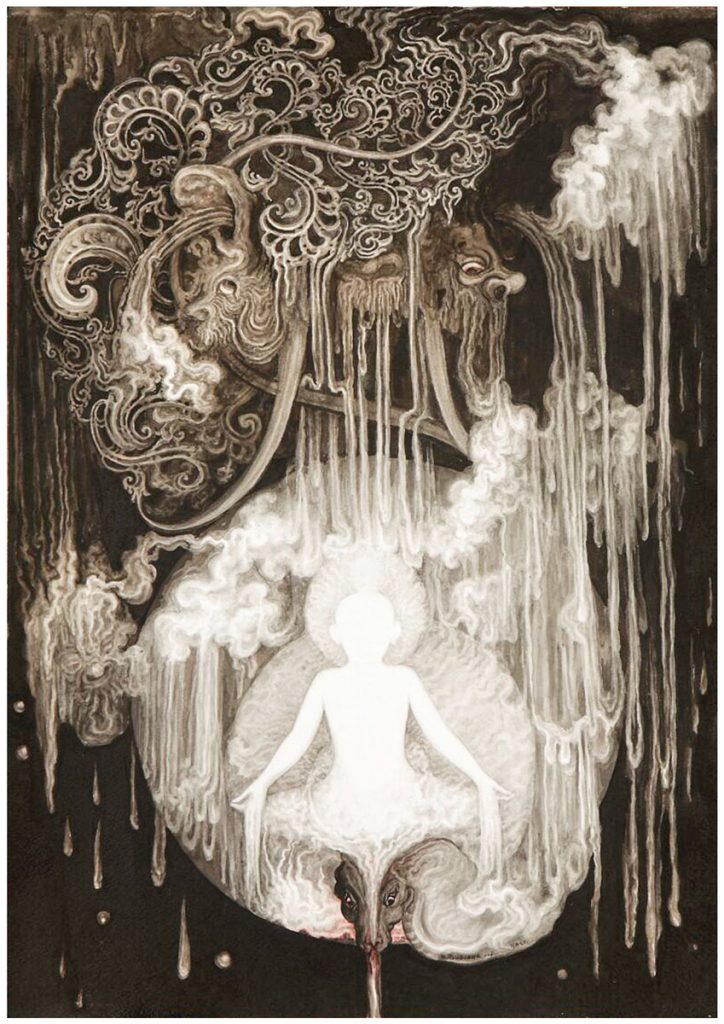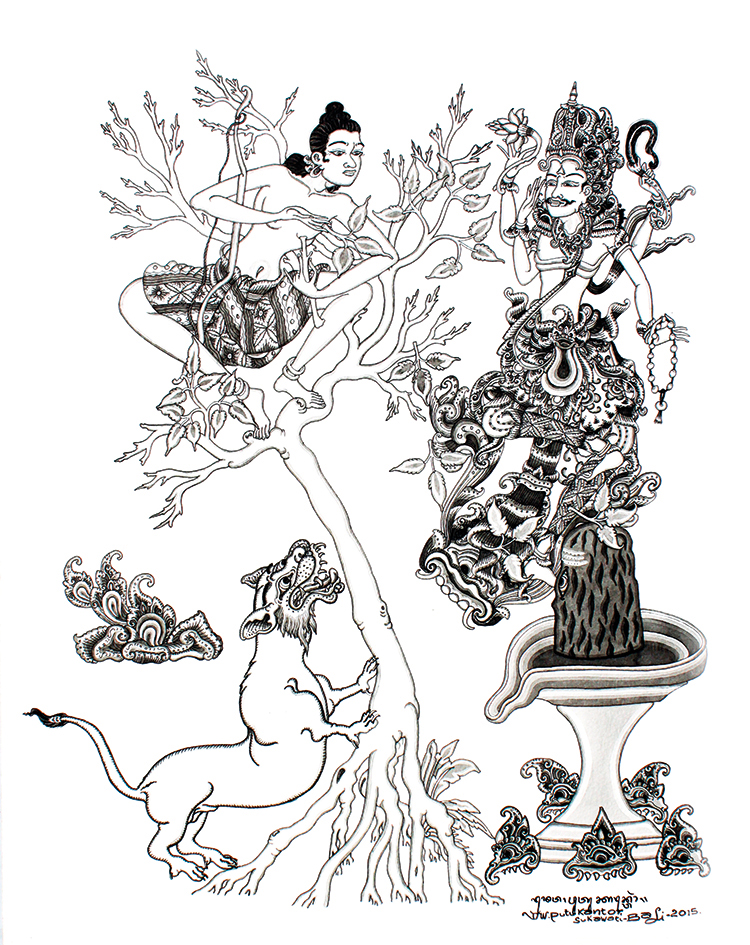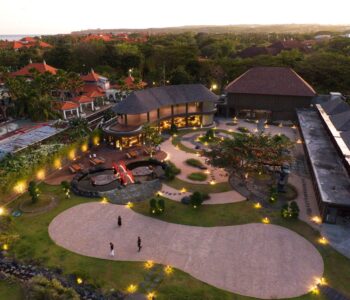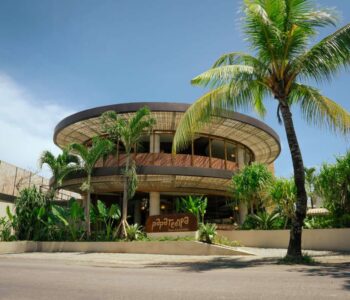The longest night of the year is a important ritual moment in the life of the Balinese. In the local lunar-solar Saka calendar, it falls on the 14th panglong lunar day of the seventh (Kapitu) month. Fully dedicated to the cult of Siwa, this night is called the Night of Siwa, or Siwa Ratri.

The Siwa Ratri is a night of meditation aimed at cleansing the impurities accumulated during the year. People who participate don’t sleep during the whole night. They pray, meditate and discuss holy texts in the temple of the dead (Pura Dalem) or the temple of origin (Pura Puseh). Barely known forty years ago, Siwa Ratri is now one of the most popular holy days of modern Bali.
Siwa Ratri wake is inseparable from the story of the hunter Lubdaka, which is the principal object of the reading sessions and related discussions. Some sort of “cleansing wake” might well have predated the Lubdaka story historically, but the latter in turn has strongly influenced the holding of the ritual, especially in modern Bali.
The story goes as follows: Having lost his way in the forest on the arrival of the night of Siwa, Lubdaka, as the sun is setting, finds himself obliged to take refuge in a bila tree overlooking a lake. Tigers and other wild animals wait at the foot of the tree to kill and eat him if he were to fall. To pass the time, Lubdaka picks up the leaves, one by one, and throws them into the lake. A big lingga – phallic symbol of Siwa — then emerges in the middle of the lake. Lubdaka eventually survives the dangerous Night of Siwa. After his death, instead of sending him to hell as punishment for his sins –he is by birth a vile, low-caste Nisada hunter– the God Siwa grants him ultimate enlightenment: Lubdaka had been cleansed by his involuntary meditation on the shore of the lake.
The forest is a symbol of the wilderness of life; the wild animals, of the temptations of life; the vile hunter represent the people of low caste; and the lingga is the symbol of Siwa. The story, hence, points to the role of meditation as a means to achieve release, not only for people of high caste, but for everyone, whatever one’s social status.
The oldest mention of the Night of Siwa, in the Javano-Balinese Hindu tradition, goes as far back as the end of the fourteenth century, when it became the topic of a Kakawin poem, the Siwara–trikalpa, written by Mpu Tanakung. Hinduism was then on the wane in Java, following the development of inter-insular and international trade and the related acceleration of the Islamization process. The poem depicts in a sad tone the run-down temples the hero meets on his way. This bespeaks the decadence and erosion of the Shivaite tradition in the last years of the Majapahit Empire (14th-16th centuries).

By its very being the writing of the poem bears witness to an intellectual Hindu resistance to the Islamization progress. No mention is made of Islam. But we can surmise that its expansion was by large a relatively pacific one.
No less importantly, the poem attests to the existence of relations between South India and Hindu Java. The theme of the hunter saved from hell by a meditative wake during the Night of Siwa has its origins in an Indian myth found in the Indian Padmapurana — one of the myths of the origin of the Puranas cycle. At the time of the writing of the kakawin both Hindu Java and the Southern part of the Dekkan, particularly the kingdom of Vijayanagar, were subjected to Islamic religious and political challenge, and both fell in the 16th century. It might be more than just a coincidence that king’s Srinatha’s reactivation of the ritual of the Night of Siwa in India was followed a few years later by the writing of the Siwaratrikalpa in Java. There might have been intense intellectual and political exchange between the collapsing empire of Majapahit and its Hindu-Shivaite counterparts of Southern India. In this context the fact that Lubdaka, the hero of the Siwaratrikalpakakawin, is a hunter, i.e. a “person” of low social extraction, who succeeds to achieve salvation in spite of his caste, might be construed as a Hindu answer to Islamic criticisms of the caste system: All men are the same, and all open to salvation or moksa. These ideological concessions came too late, though, to stop the revolutionary and “democratic” momentum of Islam: As Islamic trade spread first in the Indian ocean and then in the Java sea, Majapahit collapsed and Java was almost fully Moslem by the beginning of the sixteenth century. In the archipelago Hinduism survived as a structured entity only in Bali, where some elements of the Majapahit clergy took refuge.
We are witnessing in Bali a revival of the Siwaratri wake. Various old Balinese texts, such as the Brata Siwaratri and the Puja Siwaratri deal with fasting and prayers to be performed during the Night of Siwa (Siwaratri). But the ritual was never popular amongst ordinary people. The Dutch scholar Goris does not mention it at all. Hooykaas said that it was reserved for the kings. If these scholars are to be believed, the reintroduction and popularisation of the ritual is very recent indeed. Before the mid seventies, it seems to have been only practiced by a few pemangku and pedanda priests.
It is difficult to date the exact revival or, even, reinvention, of the Siwa Ratri wake. The mid-seventies is a guess. Several factors might have played a role. “The Siwaratri poem of Mpu Tanakung” was translated in 1969 by Prof. Teew, but it was not before 1976 that it appeared in articles in Indonesian from scholars such as Ida Bagus Oka Punya Atmaja and Ida Bagus Agastia — “Sekelumit materi tentang cerita Lubdaka “ by I.B. Punyatmaja, Warta Hindu Dharma 101, 1975; and “Lubdaka: Si Pemburu“ by I.B. Agastia, warta Hindu Dharma 112, 1976. These scholars, to the difference of their foreign predecessors, were not only learned men, but also Hindu activists eager to better implement the principles of their religion by giving it a more orthodox Hindu flavour. They tended to emphasize texts more than rituals inherited from the local tradition. They also wrote the result of their research in Indonesian, as opposed to in Balinese. Another related factor is the deep “structural”change taking place in the practice of Balinese Hinduism, owing in particular to the development of modern education. Many modern-educated Balinese tend to discard, or only reluctantly accept, the traditional version of their religion– collectively practiced in a village environment, focused around deities and symbols they have little understanding of. They shift to a more “rational” Hindu orthodoxy, with its clear cosmological symbolism of “Indian” Hindu gods –such as Brahma, Wisnu, Siwa. Rather than making offerings, they prefer praying. This is the “bakti” movement, a deep reformist tendency within Balinese Hinduism. The Siwaratri “wake” can be construed as part of this “bakti” movement.
The “rediscovery” of Siwa Ratri and its “rebirth” as a major religious manifestation can thus be construed as a Pan-Hindu development, which “modernizes” the practice of religion while reestablishing bonds long forgotten between Indianized Indonesia and India. Hindus of the two countries now perform Siwaratri meditation. The Night of “Siwa” or Siwaratri is one of the ways Hindu Indians and Hindu Indonesians are reopening their bonds of old.









